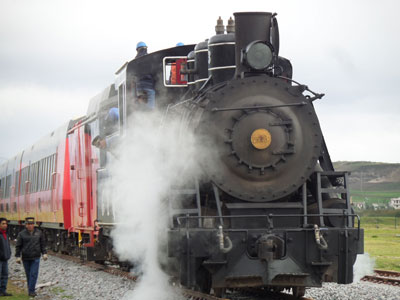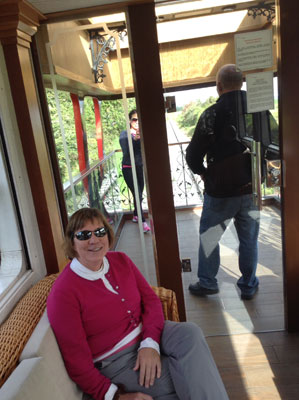Tren Crucero in Ecuador
This item appears on page 31 of the January 2015 issue.
My wife, Patti, and I had made arrangements for a stay in the Galápagos Islands, but we also wanted to see the Andes in South America and some of the Ecuadorian village areas where she had served in the Peace Corps. A short news item about Ecuador’s new Tren Crucero, or Cruise Train (Aug.’13, pg. 4), sealed the deal.
For our mainland trip, Jan. 11-17, 2014, we made arrangements through an agency in Quito, Ecuador, that had been highly rated on TripAdvisor.com: EQ Touring (phone, in the US, 866/454-9060 or 347/721-9006, www.eqtouring.com). We had a lot of questions, and general manager Jorge Villalobos answered our emails within hours.
The cost of our mainland portion — including hotels in Quito and Guayaquil, transfers and the train — was just about $4,200 for the two of us. (The cost of just the train trip, as of early February 2014, was $1,270 per person, one way, for the four days and three nights).
We made our own air arrangements, and, with our new Global Entry (GOES) memberships, we were able to use the expedited-security-check line when departing Tampa and through Miami. EQ Touring handled all the airport paperwork for our flight to the Galápagos.
Quito’s new Mariscal Sucre International Airport is about 20 miles from the city, and the train station is in a rather questionable industrial area in the city’s south, so transfers were essential, but we had heard of untrustworthy and unlicensed taxis in Ecuador. Andres, a knowledgeable, English-speaking driver from EQ Touring, picked us up in a private car and also, three days later, delivered us to the train.
Now in my 70s, I was concerned about the effects of high altitude, as Quito is above 9,000 feet and the train gets to almost 12,000, so we opted for three nights in Quito to give us time to adjust to the altitude and also to see the city and countryside using the new hop-on/hop-off Quito Tour Bus (Alfonso de Lamartine E10-39 y Paris, Quito; phone +593 2435 458, www.quitotourbus.com).
On Sundays, the bus offers an all-day trip north to the Center of the Earth, where you can stand with one foot in each hemisphere and have lunch at one of a number of nice restaurants.
In Quito, our cozy room at Hostal de La Rábida (La Rábida 227 y Santa Maria, Quito, Ecuador; phone +593 2222 2169, www.hostalrabida.com) was great, with a large private terrace. There also were garden rooms off an enclosed courtyard. In the evening, we were able to meet other travelers in the living room, enjoying a glass of wine by the fire.
In Guayaquil we overnighted at Mansión del Río (Numa Pompilio Llona 120, Guayaquil, Ecuador; phone +593 4256 6044, www.mansiondelrio-ec.com/en), in the safe, tourist-friendly area near the river.
Tren Crucero departs from Quito every other Tuesday promptly at 8 a.m. On alternate weeks, it returns from Guayaquil.
Operated by the Ecuadorian government, it had just begun running in August 2013 and was a work in progress. For example, the website (www.ecuadorbytrain.com) listed the overnight haciendas and hotels, but those could change at the last minute. At the end of the trip, passengers were being asked to rate the accommodations, and any that didn’t measure up would be exchanged for others. Our group of 41 passengers rated two as great and one as not up to standard.
Because the website is loaded with pictures, informative descriptions and video, I won’t attempt to describe everything. The website is accurate, as far as it goes, but doesn’t make it clear that only short portions of the trip will be with the antique steam engines. (Those engines aren’t strong enough to pull the new luxury coaches up some of the steep Andes inclines.)
Also not shown is the security convoy of motorcycles that appeared at every stop and crossing. The train being new, the crossings had no gates, so the security was for motorists as well as for passengers. It appeared the country was very proud of this train and wanted no unhappy incidents.
Speaking of proud, on our trip the train whistle brought out throngs of locals waving and cheering everywhere we went. Standing on the rear observation deck waving back, I felt like President Harry Truman campaigning back in the last century.
The Andes are high, often with steep inclines and descents. At one point we were stopped while the crew inspected the brakes. They decided we needed to be bused the few miles to the next stop. We were delayed again while the crew removed a tree that had fallen across the tracks. Who knew gas chain saws were standard equipment on a train?
Here are some notes on visiting Ecuador (and the Galápagos).
Ecuador’s currency is the US dollar, but you will want small bills, as we were never able to use a 100-dollar bill. ATMs dispensed small bills; with our brokerage card, fees were waived.
Electricity was 120V, with most outlets taking the standard US plugs. The train had a 220V outlet at each table.
In the Galápagos, however, the electricity was from diesel generators, and an apparent power surge fried the motherboard in my laptop. I suggest carrying a small, travel-type surge protector from Amazon.com (around $10).
Free WiFi was available at all of our overnight locations in Ecuador, but it was less than great in the Galápagos.
Ecuadorians say they do have four seasons, just all in the same day. We got sunburned in high-altitude Quito even though the weather was not hot. Mornings could be cool and afternoons were pleasant, with a bit of rain, perhaps. Layering of clothing was definitely required in the high mountains. We had sleet at the volcanoes and steamy heat in Guayaquil.
Ecuador has set a monthly minimum wage for service workers, so, typically, 10% is automatically added to restaurant and hotel bills. Small tips were appreciated. On the train, we tipped $100 into a pool for the excellent staff, guides and crew.
Our GOES membership worked like a charm. We had special screening, no lines to stand in, and upon our reentering Miami, Customs was speedy and easy.
TONY LEISNER
Tarpon Springs, FL



